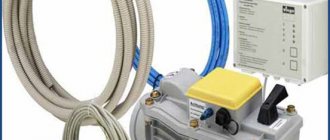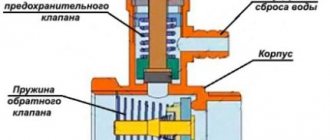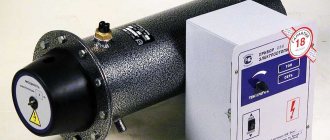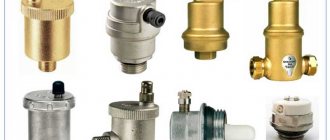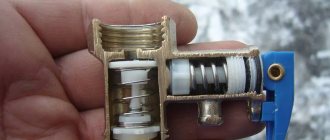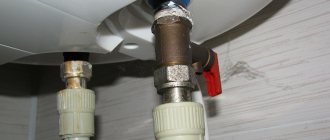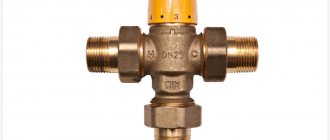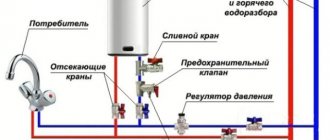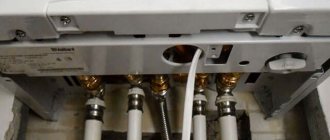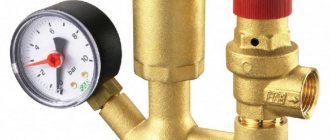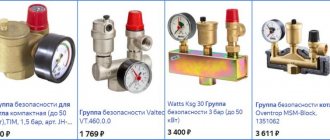What is it and what is it for?
A check valve is one of the elements of protective pipeline fittings.
The main purpose is to prevent changes in the direction of water flow. It automatically closes the pipeline if the flow direction changes in the opposite direction.
Water check valve
Also performs the following functions
- When the water supply is turned off, it prevents its outflow through the riser
- Blocks hot water from entering the cold water supply system and vice versa
- Significantly reduces the likelihood of water hammer
- Increases the operating time of equipment (pumps, meters, etc.)
- Reduces the risk of broken connections in the plumbing system
Where is it used?
A non-return valve is very useful in the water supply of a private home.
If for some reason the pump stops, it prevents water from flowing back into the well or borehole. In the event of a power outage or pump shutdown, there is no need to refill the system with water.
On water pipes.
The supply of hot and cold water in private and apartment buildings is carried out through different pipes. Sometimes different water pressure causes hot water to fill cold water pipes. The valve allows you to bring the pressure back to normal.
In front of the cold and hot water meter.
Helps protect against damage in the event of a water hammer.
At the inlet to the water heater.
The boiler is filled under pressure. When warming up and pressure increases, the displaced coolant will be directed back into the cold pipe. Prevents churn
Operating principle of a check valve
- The flow of water flowing through the pipes under pressure acts on the shut-off element and presses out the spring, which keeps the valve closed.
- After the spring has compressed, the valve opens and water flows freely through it in the desired direction.
- When the pressure in the water supply drops or when water moves in the opposite direction, the spring mechanism of the device moves the valve to the closed state.
- All the actions of the shut-off valve prevent the formation of backflow in the water supply system.
Operating principle of a check valve
Direct and indirect acting valve
Pressure control valves are divided into direct and indirect acting devices.
- The first type of valve has a simple design: a spring is driven by a shutter, which is directly pressed by the coolant. Such devices are inexpensive, easy to operate, reliable, insensitive to dirt, but not very accurate in settings.
- Indirect-acting devices, also called pulse devices, have a piston-actuated main valve, a smaller pulse valve, and a pressure transducer. When the pressure changes, the small valve presses on the piston, which moves the main valve, which regulates the throughput of the device. Thus, flow control occurs indirectly, in an indirect way. Valves of this type are less reliable due to the larger number of parts and are expensive, but they can be adjusted more accurately.
Design Features
Housing material
The most common material used to make a check valve body is brass. This material is highly resistant to chemicals that may be present in water (mineral salts, oxygen, iron compounds, manganese, sulfur and others).
titanium, cast iron, steel, bronze mainly used in industrial systems
Plastic is used in polypropylene pipelines with water temperatures up to 90 degrees
Rubber or silicone sealing gasket.
Check valve device
Shutter element
It comes in the shape of a ball, cone, or “plate”. Double-leaf check valves are also used in pumping stations and water supply systems. They have a shutter in the shape of two semicircular fragments. Most often made of brass
Return mechanism.
To return the shutter to the closed state, the device has a spring. Stainless steel is most often used to make the spring (an important element of the shutter). But there are also models where, under pressure, the shutter rotates on hinges.
Nuances of proper installation
During the installation of shut-off valves, several rules should be strictly followed:
- The valve is installed strictly in the direction of coolant flow. To avoid mistakes, the product body must be marked with an arrow indicating the working direction.
- Paronite gaskets can be used to seal connections, provided that they do not reduce the diameter of the passage hole. Otherwise, the valve will exert more hydraulic pressure than intended.
- The device must be installed so that other elements of the heating system do not exert additional pressure on its body.
- It is highly advisable to install a mesh in front of the check valve for rough cleaning. This will make it possible to prevent solid particles from entering the locking mechanism, which, in turn, can lead to a violation of the tightness of the device when closed. Or use special valves with mesh.
Another important point: before installation, you need to once again make sure that the valve is selected correctly.
For example, for schemes with forced circulation, any type of device is suitable, but for gravitational systems, only a rotary petal device without a spring. Since the coolant moving by gravity will not be able to cope with the resistance of the spring.
Types of check valve
Spring (lifting)
Its design is similar to a shut-off valve. With sufficient pressure, the valve rises up, opens the hole, allowing the flow to circulate. At low pressure it falls down onto the seat and the water path is blocked. All this happens automatically.
It is used only on horizontal pipes, with mandatory vertical axial installation.
Advantages of a spring valve. Repair is possible without dismantling, as it has a removable cover. Plus it can be used at high temperatures.
High tightness. Versatility, can be used in both private and industrial water supply systems.
One of the disadvantages of spring valves is sensitivity to dirt and mineral impurities contained in water, which can damage them. But this can be solved by installing a filter.
Ball valve
The locking element in this device is a metal ball. Sometimes the ball is covered with rubber for reliability.
If there is no pressure in the water supply, the ball, under its own weight, tightly blocks the passage hole and prevents the liquid from moving in the opposite direction. When water is supplied, the resulting pressure lifts the ball, opening the way for the water flow.
Ball check valve
Pros. Ball check valves can be installed in vertical and horizontal pipes
Simple design and absence of mechanical components increases service life.
However, it should be remembered that with an equal internal cross-section, the outer dimensions of a ball valve are larger than that of other types of valves.
Rotary or paddle
The valve received this name because of its design.
It is based on a metal disk (“plate”) and an axis with a spring. The axis of rotation is located above the through hole. When open, the disc is parallel to the movement of water; when closed, it is perpendicular. Under fluid pressure, the disc opens. When the pressure drops, the spring is activated, the disk turns and blocks the flow. rotates under fluid pressure. If the pressure drops, the spring is activated and the disk blocks the path of water
The disadvantage is that in valves of large diameter there is a strong impact when slamming, which can lead to rapid failure of the structure.
Rotary check valves are divided into two groups:
Simple - with a small diameter of up to 400 mm. Used in systems where shocks cannot greatly affect the operation of the hydraulic system and the valve itself
Impactless - valves with a special mechanism that ensures smooth closing of the disc. The downside is that they are more expensive.
Double check valve
This device has two locking segments, which are located on a rotating axis. The plates are located in the center of the passage hole.
Water moving in the right direction opens the doors. If the direction of flow changes, the plates, under the action of springs, close the passage of the liquid.
Butterfly valves come in a wide range of sizes so they can be installed on pipes of various diameters.
They are also recommended for installation in systems where high pressure is present.
Recommendations for selection
Typically, electric water heaters are equipped with safety valves. But there are often situations when a separate purchase and installation of a valve is required, including for an indirect heating boiler.
The main criterion by which the device is selected is the maximum permissible operating pressure of the water heater. Its value can be found among the technical characteristics indicated in the product passport.
Important. When choosing a valve, you cannot rely on the pressure in the water supply network; it can fluctuate over a very wide range. Only the boiler’s passport data should be taken as a basis.
On the modern market, various manufacturers offer valves with response pressure from 6 to 10 Bar, with a setting increment of 0.5 Bar. To be completely safe, you can select a safety element whose response pressure is 0.5 bar lower than the maximum permissible specified in the documentation of the water heater.
In this regard, the choice of a safety valve for an indirect heating boiler is no different from the selection of a device for a conventional electric water heater, because the physical principles of liquid expansion operate the same everywhere. The only thing that can be recommended is to purchase a valve for the indirect heater with the ability to regulate the critical pressure. But such products are expensive, and their use is not always advisable.
Important. Do not confuse the DHW valve with a similar heating device. The latter are designed for lower pressure and are not intended for constant discharge of water.
Classification by installation method
Flanged valve
With this type of device, the return flange and the supply flange are welded to the valve body and a single structure is obtained.
This type of valve is mainly used in industrial systems for large diameter pipes.
Due to its large size, it can cause water hammer, since at the moment of closing, increased pressure is created in the system. To avoid this, systems use shock-free shutters with soft closing.
Advantages: ability to work in systems with water pollution. Application on main pipelines with large pipe diameters.
Wafer
These devices have virtually no mounting hardware. The valve itself is mounted between two flanges, at the ends of the connected pipes. A special seal is placed at the installation sites. After this, the flanges are tightened together with threaded connections (bolts or studs).
If installed correctly, the valve will be securely fixed. In terms of reliability, this type of connection is almost as good as a flange connection.
Coupled
The most common in household plumbing.
With this connection, the valve is connected to the pipe using a threaded coupling.
Pros: No need to use additional fasteners. Not suitable for large diameter pipes.
Line (stream) symbols
Working, pilot and drain lines
A hydraulic hose, pipe, or other conduit that moves oil between components of a hydraulic system is indicated by a single line.
The working line (suction, discharge and return) is indicated by a solid line.
The pilot line is indicated by a dotted line with long dashes
The drainage line is indicated by a dotted line with short dashes
Connection/Transition Lines
To show that two intersecting lines are not connected, we use a short loop on one of the lines at the intersection.
The connection between two intersecting lines should be indicated by a dot at the junction.
Do I need a check valve for a water meter?
If you turn on several taps at the same time in an apartment building, pressure drops will occur in the water supply system. To avoid this, it is enough to install a check valve on the water meter, which will equalize the pressure drops.
The internal space of the meter must be constantly filled with water. This requirement allows the hydraulic check valve to be fulfilled. This will allow the meter to not fail for a long time.
If the pressure in the cold water pipe is greater than in the hot one. The meter will also start counting cold water. This will result in an increase in your utility bill accordingly. The check valve prevents cold water from entering the hot water system.
Valves that reliably block the water flow and prevent movement in the opposite direction. They will help prevent the consequences of water hammer for the water meter. This significantly increases the service life of the device.
Options for working connection schemes
Heating systems are very diverse and the presence of a check valve is not necessary in all of them. Let's consider several cases when its installation is necessary. First of all, a check valve must be installed on each of the individual circuits in a closed circuit, provided that they are equipped with circulation pumps.
Some craftsmen strongly recommend installing a spring-type check valve in front of the inlet pipe of the only circulation pump in a single-circuit system. They motivate their advice by the fact that in this way pumping equipment can be protected from water hammer.
This is in no way true. Firstly, installing a check valve in a single-circuit system is hardly justified. Secondly, it is always installed after the circulation pump, otherwise using the device loses all meaning.
If two or more boilers are included in the heating circuit, the occurrence of parasitic flows is inevitable. Therefore, connecting a check valve is mandatory
For multi-circuit systems, the presence of a reverse-acting shut-off device is vital. For example, when two boilers are used for heating, electric and solid fuel, or any others.
When one of the circulation pumps is turned off, the pressure in the pipeline will inevitably change and a so-called parasitic flow will appear, which will move in a small circle, which can lead to trouble. It is impossible to do without shut-off valves here.
A similar situation arises when using an indirect heating boiler. Especially if the equipment has a separate pump, if there is no buffer tank, hydraulic arrow or distribution comb.
Here, too, there is a high probability of a parasitic flow, to cut off which a check valve is needed, which is used specifically for arranging a branch with a boiler.
It is mandatory to use shut-off valves in systems with bypass. Such schemes are usually used when converting a scheme from gravitational fluid circulation to forced circulation.
In this case, the valve is placed on the bypass parallel to the circulation pumping equipment. It is assumed that the main mode of operation will be forced. But if the pump is turned off due to lack of electricity or breakdown, the system will automatically switch to natural circulation.
When installing bypass units for heating circuits, the use of check valves is considered mandatory. The figure shows one of the possible bypass connection options
This will happen as follows: the pump stops supplying coolant, the check valve actuator unit ceases to experience pressure and closes.
Then the convection movement of the liquid along the main line resumes. This process will continue until the pump starts working. In addition, experts suggest installing a check valve on the make-up pipeline. This is not necessary, but highly desirable, since it allows you to avoid emptying the heating system for a variety of reasons.
For example, the owner opened a tap on the make-up pipeline to increase the pressure in the system. If, by an unpleasant coincidence, the water supply is cut off at this moment, the coolant will simply squeeze out the remaining cold water and go into the pipeline. As a result, the heating system will be left without liquid, the pressure in it will drop sharply and the boiler will stop.
In the circuits described above, it is important to use the correct valves. To cut off parasitic flows between adjacent circuits, it is advisable to install disk or petal devices. In this case, the hydraulic resistance will be lower in the latter option, which must be taken into account when choosing.
In heating systems with natural coolant circulation, the use of spring check valves is impractical. Only paddle rotators can be installed here
To install a bypass unit, it is preferable to choose a ball valve. This is due to the fact that it provides almost zero resistance. A disc-type valve can be installed on the make-up pipeline. This should be a model designed for fairly high operating pressure.
Therefore, a check valve may not be installed in all heating systems. It is necessarily used when installing bypasses of all types for boilers and radiators, as well as at pipeline branch points.
Where to install
- If necessary, a check valve is installed where it is necessary to ensure flow movement in one direction.
- After the water meter, to protect against water hammer
- On hot and cold water pipes when used simultaneously. Due to the pressure difference, overflow through the mixer is possible
- At the water heater inlet to prevent heated water from escaping into the cold water supply system
- In front of the pump or pumping station to prevent the outflow of water in the event of a power outage or breakdown
- At the very inlet of the suction pipe
- In the anti-drip protection system of the dishwasher and washing machine
Where in the apartment should I install a check valve - video
How to install correctly
The easiest way to install a check valve is through a threaded coupling. Suitable for installation in the water supply system of an apartment or private house.
Work order (step by step instructions)
Select location, see above
Prepare fittings of the required diameter.
Wrap a sealant around the thread (linen, fum tape, thread)
Use a fitting to secure the check valve
Open the tap and check for leaks
If you are unsure or doubt your capabilities, call a plumber
It is important! There is an arrow on the valve body. The direction of the arrow must coincide with the direction of water flow in the pipeline
Even the most reliable shut-off valves fail over time. Therefore, you need to know how to remove the check valve yourself.
- First you need to turn off the water flow with taps
- if necessary, drain from the system
- Then unscrew the nuts.
- Dismantling flanges or fittings
- Remove the check valve.
- If possible, replace failed parts (for example, a spring)
- Reassemble in reverse order.
.
Attention! If the valve is installed near the water meter. You must act carefully so as not to damage the seal installed by the management company.
Possible errors and problems during installation
The device may fail due to installation errors.
During the installation process, be sure to follow the instructions
It is advisable to inspect for problems once a month.
Possible problems:
No water flow
Incorrect installation. The arrow shows the direction of flow.
What to do: Disassemble and unfold the valve
During installation, the plug or the shutter retainer was not removed. This will result in the device not allowing liquid to pass through.
Solution: Dismantle, remove plug or retainer
The valve does not hold well
does not seal tightly.
A solid particle may enter and prevent the passage from being completely blocked.
What to do: First, try to wash off the trapped debris with a stream of water. You need to open and close the nearest shut-off valve several times. If this does not help, disassemble the check valve, rinse it well and reinstall it
The threaded coupling has burst.
This happens when there is a heavy load in the pipeline, a defective product, or too much sealing material is wound.
What to do: Can only be fixed by replacing the product
Tapping
After installing the check valve, knocking noises are heard. This can happen due to the larger valve diameter. Another option: installed too close to the pump.
Solution: in the first case, purchase a device with a smaller diameter. In the second, rearrange it to a more suitable place.
How to adjust the safety valve?
In fact, all these devices have a factory preset, which is not allowed to be changed, and in most designs it is impossible. Nevertheless, there are valves with an adjusting screw; tightening or unscrewing it changes the compression force of the spring, and therefore the response threshold of the product. But remember that by changing the position of the screw in one direction or another, you have set the new critical pressure very approximately, and this is unreliable in terms of safety.
The correct way is to adjust the safety valve using the selection method according to the nameplate pressure and nothing else. The exception is adjustable devices with a printed scale, but there is no point in installing them, since the maximum operating pressure of the boiler is a constant value. Therefore, purchase and install high-quality products in accordance with technical requirements and they will serve properly for a long time.
Advice and recommendations from experts
To avoid mistakes during installation, we recommend reading expert advice:
- The direction of the arrow on the valve body and the direction of fluid flow in the water supply must match.
- The device must be installed in places where there is easy access. This is necessary so that the check valve can be inspected or repaired in the future.
- Before installation, check the device for leaks.
- Valves made of steel and brass have a longer service life. Since they are more resistant to corrosion and pressure changes.
- It should be installed after the metering device.
So that the water check valve installed in the water supply system can function correctly for a long time. It is necessary to carry out installation according to the rules specified in the instructions
